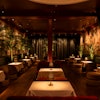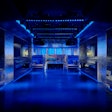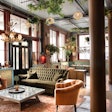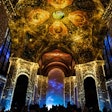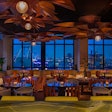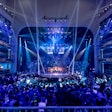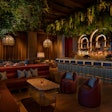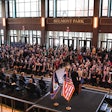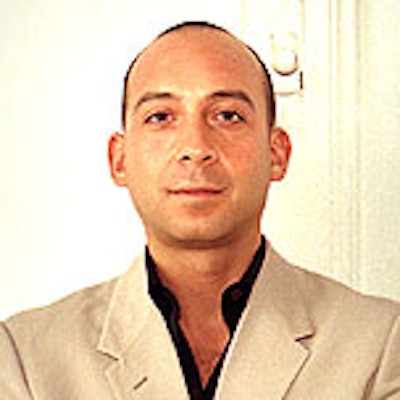
Kevin Calica is vice president and creative director of special events and global communications at Calvin Klein, where he is responsible for 30 to 50 events around the world each year. In addition to the designer's fashion shows—including this Thursday's Spring 2003 show at Milk Studios—Calica oversees events that support Calvin Klein's PR and marketing strategies, as well as the company's wholesale, retail and licensee sales. Calica started at Calvin Klein in 1995 as a visual director, working on displays in retail stores and at events; he has been at his current position for three years.
BiZBash: When you're planning fashion shows twice a year, every year, how do you keep them fresh?
Calica: First of all, the only thing that's going to be new is the clothing. In terms of the production we rely on KCD to help us with the casting, etc., but the focus is on the merchandise. We're very consistent in our use of venue [having used Milk Studios for years] and that consistency is really what we're looking for in terms of our presentation, so it can provide a backdrop that allows the clothes to be as fresh and exciting as possible.
That's the opposite of what many people in fashion and events do—they try to be different all the time.
I think that's Calvin's area of expertise and genius. He's been a clothing designer for more than 30 years, and he's always remained not only consistent but completely contemporary and modern for whatever time he's doing something. Consistency is what has allowed him to create his own very clear vision of what he wants to do and the message he wants to convey.
What are the challenges that come with keeping events consistent in that way?
It's sort of like when you're driving down the road and you have these lines on either side of the road that you have to stay within. We're given set parameters, because we're working for the brand. We have to drive within these parameters while also keeping it really exciting and fresh. The key is to support the product, because that's what continues to change. Our job on the presentation side is to know what's happening out there in the world with our competitors and to stay on the crest of the wave with whatever's happening.
Do you think event styles change the way clothing fashions change?
Absolutely. As long as I've been doing this, I've been going to events and I make it a point to go to as many as possible to see what's happening, from what's being served, to what drinks are popular, to what the waiters are wearing, to what people are doing at events. Since I took over as creative director, it is really our intention to refocus and relook at each event, why we do it, and what we're hoping to achieve from it. I notice a lot of changes.
What are you seeing now?
Obviously post-September 11, there was a certain sobriety at events. And in New York specifically, where there's such a survivor instinct, the intention is behind getting back into it, and having fun again, which is great because people want to go out and be around one another and see what's happening.
I think that the challenge is how to really do an event efficiently, meaning that just throwing a lot of money on a project is not really the answer-whereas I think when I first starting doing this that could have passed. I've been to a lot of events where a lot of money has been spent, and I think that they fail because the intention of the event is not clear.
Posted 09.17.02
Photograph by Anna Persson for BiZBash
BiZBash: When you're planning fashion shows twice a year, every year, how do you keep them fresh?
Calica: First of all, the only thing that's going to be new is the clothing. In terms of the production we rely on KCD to help us with the casting, etc., but the focus is on the merchandise. We're very consistent in our use of venue [having used Milk Studios for years] and that consistency is really what we're looking for in terms of our presentation, so it can provide a backdrop that allows the clothes to be as fresh and exciting as possible.
That's the opposite of what many people in fashion and events do—they try to be different all the time.
I think that's Calvin's area of expertise and genius. He's been a clothing designer for more than 30 years, and he's always remained not only consistent but completely contemporary and modern for whatever time he's doing something. Consistency is what has allowed him to create his own very clear vision of what he wants to do and the message he wants to convey.
What are the challenges that come with keeping events consistent in that way?
It's sort of like when you're driving down the road and you have these lines on either side of the road that you have to stay within. We're given set parameters, because we're working for the brand. We have to drive within these parameters while also keeping it really exciting and fresh. The key is to support the product, because that's what continues to change. Our job on the presentation side is to know what's happening out there in the world with our competitors and to stay on the crest of the wave with whatever's happening.
Do you think event styles change the way clothing fashions change?
Absolutely. As long as I've been doing this, I've been going to events and I make it a point to go to as many as possible to see what's happening, from what's being served, to what drinks are popular, to what the waiters are wearing, to what people are doing at events. Since I took over as creative director, it is really our intention to refocus and relook at each event, why we do it, and what we're hoping to achieve from it. I notice a lot of changes.
What are you seeing now?
Obviously post-September 11, there was a certain sobriety at events. And in New York specifically, where there's such a survivor instinct, the intention is behind getting back into it, and having fun again, which is great because people want to go out and be around one another and see what's happening.
I think that the challenge is how to really do an event efficiently, meaning that just throwing a lot of money on a project is not really the answer-whereas I think when I first starting doing this that could have passed. I've been to a lot of events where a lot of money has been spent, and I think that they fail because the intention of the event is not clear.
Posted 09.17.02
Photograph by Anna Persson for BiZBash


